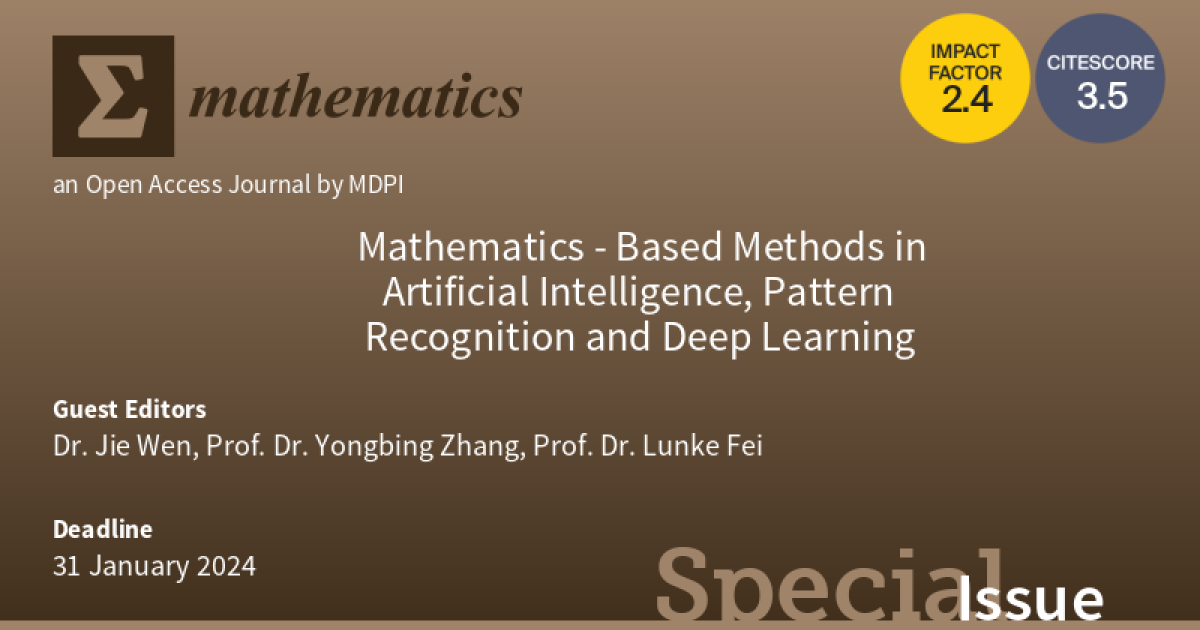Mathematics-Based Methods in Artificial Intelligence, Pattern Recognition and Deep Learning
A special issue of Mathematics (ISSN 2227-7390). This special issue belongs to the section "E1: Mathematics and Computer Science".
Deadline for manuscript submissions: closed (31 January 2024) | Viewed by 70714

Special Issue Editors
Interests: machine learning; data mining; pattern recognition; computer vision
Special Issues, Collections and Topics in MDPI journals
Interests: computational imaging; computer vision; biomedical image processing
Special Issue Information
Dear Colleagues,
Artificial intelligence, pattern recognition, and deep learning have become hot topics in recent years. From basic necessities to aerospace, pattern recognition, deep learning, and artificial intelligence are everywhere. For example, face recognition, fingerprint recognition, and palmprint recognition are widely used for access control and attendance systems in daily life. We often enjoy smart product recommendations from many shopping platforms. Automatic driving cars, virtual reality, navigation and positioning, and beauty camera software in mobile phones are also representative applications of artificial intelligence, pattern recognition, and deep learning. In fact, all of the artificial intelligence, pattern recognition, and deep learning algorithms highly rely on mathematical modeling and mathematical calculation. Good mathematical models and efficient calculation algorithms are crucial to success in these applications. For instance, it is very important to design a robust and efficient mathematical model for behavioral decisions in the application of multi-view information-based autonomous driving. The aim of this Special Issue is to highlight recent advances in mathematics-based methods in artificial intelligence, pattern recognition, and deep learning. Papers with interesting/significant new applications of artificial intelligence, pattern recognition, and deep learning are also welcome.
Topics of interest include, but are not limited to:
- Mathematics-based methods in artificial intelligence;
- Mathematics-based methods in pattern recognition;
- Biometric recognition algorithms and applications, such as face recognition, palmprint recognition, eye classification, fingerprint recognition;
- Multi-view/-modal learning and fusion;
- Dimensionality reduction;
- Subspace learning and clustering;
- Deep-learning-based methods and applications;
- Image super-resolution/enhancing/restoration;
- Mathematics-based methods in computer vision, such as object tracking and detection;
- Sparse representation and application.
Dr. Jie Wen
Prof. Dr. Yongbing Zhang
Prof. Dr. Lunke Fei
Guest Editors
Manuscript Submission Information
Manuscripts should be submitted online at www.mdpi.com by registering and logging in to this website. Once you are registered, click here to go to the submission form. Manuscripts can be submitted until the deadline. All submissions that pass pre-check are peer-reviewed. Accepted papers will be published continuously in the journal (as soon as accepted) and will be listed together on the special issue website. Research articles, review articles as well as short communications are invited. For planned papers, a title and short abstract (about 250 words) can be sent to the Editorial Office for assessment.
Submitted manuscripts should not have been published previously, nor be under consideration for publication elsewhere (except conference proceedings papers). All manuscripts are thoroughly refereed through a single-blind peer-review process. A guide for authors and other relevant information for submission of manuscripts is available on the Instructions for Authors page. Mathematics is an international peer-reviewed open access semimonthly journal published by MDPI.
Please visit the Instructions for Authors page before submitting a manuscript. The Article Processing Charge (APC) for publication in this open access journal is 2600 CHF (Swiss Francs). Submitted papers should be well formatted and use good English. Authors may use MDPI's English editing service prior to publication or during author revisions.
Keywords
- pattern recognition and application
- deep learning
- artificial intelligence
- computer vision
Benefits of Publishing in a Special Issue
- Ease of navigation: Grouping papers by topic helps scholars navigate broad scope journals more efficiently.
- Greater discoverability: Special Issues support the reach and impact of scientific research. Articles in Special Issues are more discoverable and cited more frequently.
- Expansion of research network: Special Issues facilitate connections among authors, fostering scientific collaborations.
- External promotion: Articles in Special Issues are often promoted through the journal's social media, increasing their visibility.
- Reprint: MDPI Books provides the opportunity to republish successful Special Issues in book format, both online and in print.
Further information on MDPI's Special Issue policies can be found here.







